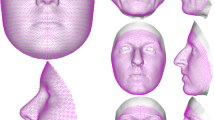Abstract
DeCA (Dense Correspondence Analysis) is an open-source toolkit for biologists that integrates biological insights in the form of homologous landmark points with dense surface registration to provide highly detailed shape analysis of smooth and complex structures that are typically challenging to analyze with sparse manual landmarks alone. In this work we demonstrate the use of DeCA by analyzing morphological differences of the skull in a dataset of 60 laboratory mice from different background strains.
Access this chapter
Tax calculation will be finalised at checkout
Purchases are for personal use only
Similar content being viewed by others
References
McBratney-Owen, B., Iseki, S., Bamforth, S.D., Olsen, B.R., Morriss-Kay, G.M.: Development and tissue origins of the mammalian cranial base. Dev. Biol. 322(1), 121–132 (2008)
Hutton, T.J., Buxton, B.R., Hammond, P.: Dense surface point distribution models of the human face. In: Proceedings IEEE Workshop on Mathematical Methods in Biomedical Image Analysis (MMBIA 2001), pp. 153–160. IEEE (2001)
Claes, P., Walters, M., Vandermeulen, D., Clement, J.G.:Spatially‐dense 3D facial asymmetry assessment in both typical and disordered growth. J. Anat. 219(4), 444–455 (2011)
Kornreich, D., Mitchell, A.A., Webb, B.D., Cristian, I., Jabs, E.W.: Quantitative assessment of facial asymmetry using three-dimensional surface imaging in adults: validating the precision and repeatability of a global approach, pp. 126–131 (2016)
White, J.D., et al.: MeshMonk: open-source large-scale intensive 3D phenotyping. Sci. Rep. 9(1), 6085 (2019)
Rolfe, S., Lee, S.-I., Shapiro, L.: Associations between genetic data and quantitative assessment of normal facial asymmetry. Front. Genet. 9, 659 (2018)
Fedorov, A., et al.: 3D Slicer as an image computing platform for the quantitative imaging network. Magn. Reson. Imaging 30(9), 1323–1341 (2012)
Porto, A., Rolfe, S., Maga, A.M.: ALPACA: A fast and accurate computer vision approach for automated landmarking of three‐dimensional biological structures. Methods Ecol. Evol. 12(11), 2129–2144 (2021)
Rolfe, S., et al.: SlicerMorph: an open and extensible platform to retrieve, visualize and analyze 3D morphology. Methods Ecol. Evol. 12(10), 1816–1825 (2021)
Bookstein, F.L.: Principal warps: thin-plate splines and the decomposition of deformations. IEEE Trans. Pattern Anal. Mach. Intell. 11(6), 567–585 (1989)
Adams, D.C., Otárola-Castillo, E.: Geomorph: an R package for the collection and analysis of geometric morphometric shape data. Methods Ecol. Evol. 4(4), 393–399 (2013)
Schlager, S.: Morpho and Rvcg–shape analysis in R: R-Packages for geometric morphometrics, shape analysis and surface manipulations. In: Statistical shape and deformation analysis, pp. 217–256. Academic Press (2017)
Acknowledgement
Parts of this research were funded by the National Science Foundation Award [OAC 2118240] (Imageomics Institute) and National Institute of Dental and Craniofacial Research (DE027110) to AMM.
Author information
Authors and Affiliations
Corresponding author
Editor information
Editors and Affiliations
Rights and permissions
Copyright information
© 2023 The Author(s), under exclusive license to Springer Nature Switzerland AG
About this paper
Cite this paper
Rolfe, S.M., Maga, A.M. (2023). DeCA: A Dense Correspondence Analysis Toolkit for Shape Analysis. In: Wachinger, C., Paniagua, B., Elhabian, S., Li, J., Egger, J. (eds) Shape in Medical Imaging. ShapeMI 2023. Lecture Notes in Computer Science, vol 14350. Springer, Cham. https://doi.org/10.1007/978-3-031-46914-5_21
Download citation
DOI: https://doi.org/10.1007/978-3-031-46914-5_21
Published:
Publisher Name: Springer, Cham
Print ISBN: 978-3-031-46913-8
Online ISBN: 978-3-031-46914-5
eBook Packages: Computer ScienceComputer Science (R0)





